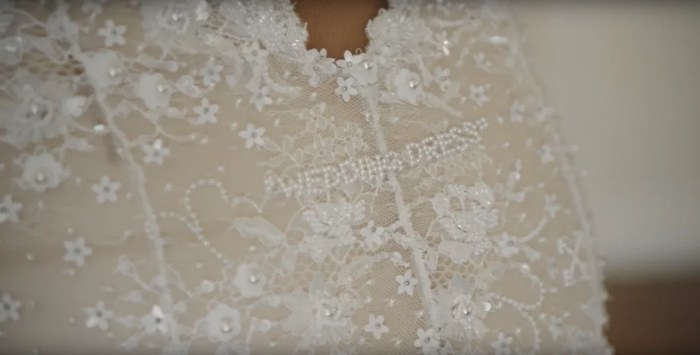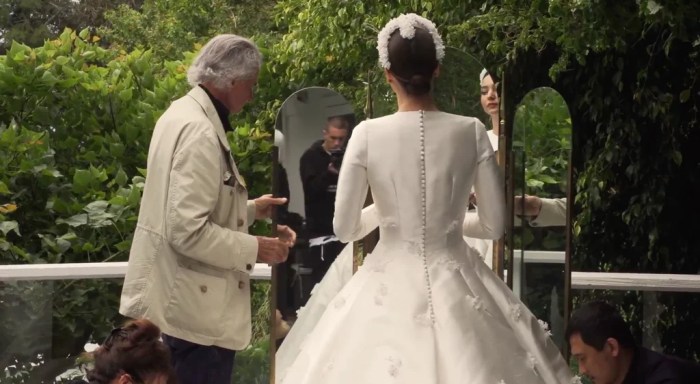Wedding Dresses in 2010 A Retrospective
Popular Wedding Dress Styles of 2010
Wedding dresses in 2010 – The year 2010 showcased a diverse range of wedding dress styles, reflecting a blend of classic elegance and contemporary trends. Several dominant silhouettes, necklines, sleeve styles, and fabrics defined the bridal fashion landscape of the year.
Dominant Silhouettes in 2010 Wedding Gowns
A-line gowns remained a perennial favorite, offering a flattering silhouette for various body types. Ball gowns, with their full skirts and structured bodices, also enjoyed significant popularity, creating a dramatic and romantic look. Sheath gowns, characterized by their sleek and form-fitting designs, provided a more modern and sophisticated alternative. Empire waist gowns, with their high waistlines, offered a graceful and timeless aesthetic.
Necklines and Sleeve Styles in 2010 Wedding Dresses
Strapless necklines continued to be a popular choice, showcasing the shoulders and décolletage. Sweetheart necklines, with their romantic curves, also remained prevalent. Other popular options included V-necklines and halter necklines. Sleeve styles ranged from sleeveless to short sleeves, capped sleeves, and long sleeves, often featuring delicate lace or intricate embellishments.
Fabric Choices in 2010 Wedding Dress Designs, Wedding dresses in 2010
A variety of fabrics contributed to the diverse aesthetic of 2010 wedding dresses. Each fabric offered unique characteristics, influencing the overall drape, texture, and look of the gown.
| Fabric Type | Characteristics | Prevalence in 2010 | Examples |
|---|---|---|---|
| Satin | Smooth, lustrous, and luxurious; creates a sleek and elegant look. | High | Often used for A-line and sheath gowns. |
| Lace | Delicate, intricate, and romantic; adds texture and visual interest. | Very High | Used extensively in various styles, often as overlays or appliqués. |
| Tulle | Lightweight, sheer, and airy; creates volume and fullness in skirts. | High | Common in ball gowns and A-line dresses to achieve a full skirt. |
| Silk | Luxurious, soft, and drapes beautifully; lends a sophisticated feel. | Medium | Often used for simpler, more elegant designs. |
Lace and Embellishments in 2010 Wedding Dresses: Wedding Dresses In 2010
Lace and various embellishments played a significant role in enhancing the beauty and detailing of 2010 wedding dresses. The intricate work added depth and personality to the gowns.
Types of Lace and Embellishments
Chantilly and Alençon lace were particularly popular choices, known for their delicate patterns and exquisite craftsmanship. Beading, embroidery, and sequins were frequently used to add sparkle and texture to the dresses. These embellishments were often strategically placed to highlight specific design elements or create focal points.
Incorporation of Lace and Embellishments

Source: popsugar-assets.com
- Lace overlays on A-line gowns created a romantic and ethereal look.
- Intricate beading on strapless ball gowns added a touch of glamour.
- Embroidered details on the bodice of sheath gowns provided subtle elegance.
- Sequin embellishments on tulle skirts added a touch of sparkle and movement.
Wedding Dress Trains in 2010
The train length significantly impacted the overall aesthetic of the wedding gown, ranging from subtle sweeps to dramatic cathedrals. The choice often reflected the bride’s personal style and the formality of the wedding.
Train Lengths and Their Aesthetic Impact
Sweep trains, extending a few inches beyond the hem, offered a touch of elegance without being overly dramatic. Chapel trains, extending to the floor and slightly beyond, provided a more formal look. Cathedral trains, which could reach several feet in length, created a truly majestic and dramatic effect. The longer the train, the more dramatic and formal the overall look of the gown became.
Visual Representation of Train Lengths
Imagine three silhouettes: one with a short sweep train barely extending beyond the hem, creating a simple and elegant look. Next, a chapel train gracefully flowing to the floor, adding a touch of classic elegance. Finally, a long cathedral train trailing dramatically behind the bride, adding an air of grandeur and romance.
Color Trends in 2010 Wedding Dresses
While white remained the dominant color, 2010 saw a subtle shift towards incorporating other colors and shades into wedding dress designs, adding unique personality and style.
Popular Colors and Their Incorporation
Ivory, champagne, and blush tones were popular alternatives to stark white, offering a softer and more romantic feel. These colors were often incorporated as sashes, underlays, or subtle accents on the lace or embroidery. Some designers even incorporated pastel shades like light blue or lavender into the overall design, creating unique and whimsical gowns.
Impact of Color Choices
The use of off-white shades and subtle color accents added depth and complexity to the designs, moving away from the purely traditional white look. These color choices allowed brides to personalize their gowns and reflect their individual style preferences.
Influential Designers and Brands of 2010
Several prominent designers and brands significantly shaped the bridal fashion landscape of 2010, each with their distinctive design elements and styles.
Key Designers and Their Signature Styles
| Designer/Brand | Signature Style | Representative Dress Features (2010) |
|---|---|---|
| Vera Wang | Modern, romantic, often incorporating dramatic silhouettes and unique detailing. | Intricate beading, flowing fabrics, and unexpected color accents. |
| Monique Lhuillier | Romantic, feminine, with a focus on delicate lace and intricate embellishments. | Lace overlays, empire waistlines, and flowing skirts. |
| Oscar de la Renta | Classic, elegant, with a focus on luxurious fabrics and timeless silhouettes. | Structured bodices, A-line silhouettes, and clean lines. |
| Pronovias | Wide range of styles, from classic to modern, known for affordability and quality. | Various silhouettes, fabrics, and embellishments catering to diverse tastes. |
Impact of Cultural Trends on 2010 Wedding Dresses
Cultural trends subtly influenced the design elements and overall aesthetic of wedding dresses in 2010, reflecting broader societal shifts and preferences.
Wedding dress trends in 2010 showcased a diverse range of styles, from classic ballgowns to more modern silhouettes. A popular choice among brides seeking a touch of vintage charm and practicality was the tea-length wedding dress, often crafted from delicate tulle, such as those found on sites like tea length wedding dress tulle. This style offered a comfortable yet elegant alternative to the traditional floor-length gown, remaining a stylish option within the broader context of 2010 bridal fashion.
Cultural Influences and Their Manifestation
The growing emphasis on individuality and personal expression led to a wider range of styles and color choices, moving beyond traditional expectations. The continued popularity of vintage-inspired designs reflected a nostalgic appreciation for classic elegance. The influence of celebrity weddings and red-carpet fashion also contributed to certain design trends, such as the use of dramatic trains and intricate embellishments.
Reflection in 2010 Wedding Images

Source: popsugar-assets.com
Imagine photographs of 2010 weddings showcasing a diverse array of styles: a bride in a classic A-line gown with subtle lace detailing, another in a dramatic ball gown with intricate beading, and yet another in a sleek sheath gown with a modern neckline. These images would collectively demonstrate the range of styles and the impact of cultural trends on the bridal fashion of the year.
Question Bank
What were some of the less common colors seen in 2010 wedding dresses?
While white remained dominant, some designers incorporated subtle hints of blush pink, ivory, or champagne into their designs, often through sashes or underlays.
How did the economic climate of 2010 influence wedding dress choices?
The lingering effects of the 2008 recession likely influenced some brides to opt for more budget-friendly options or simpler designs, focusing on quality fabrics and classic silhouettes rather than elaborate embellishments.
Were there any significant differences in wedding dress styles between different geographical regions in 2010?
While overall trends were similar globally, regional variations likely existed, influenced by local cultural preferences and traditions. For example, certain embellishments or silhouettes might have been more popular in specific regions.



















